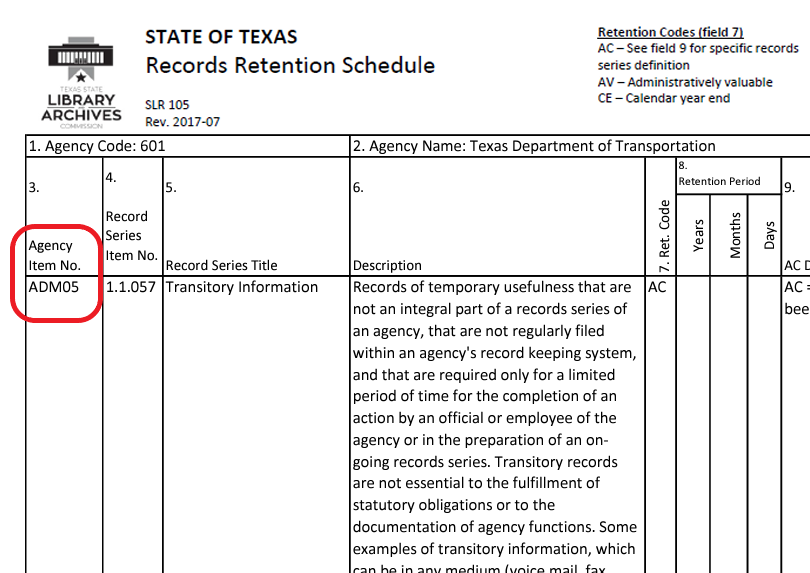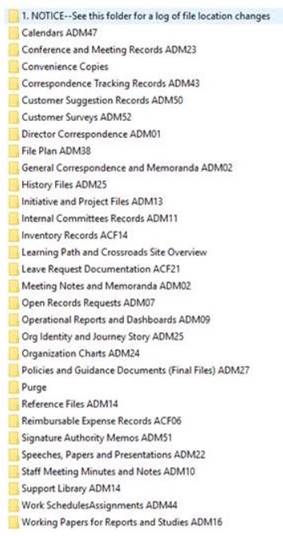Chapter 9: File Management
Anchor: #i1036325Section 1: Organizing Files
Anchor: #i1036336Overview and General Principles
The standardization of filing systems ensures that all records, regardless of media, are properly and consistently organized, identified, and maintained so they may be efficiently and effectively retrieved using standard practices and procedures. These guidelines are agnostic to the media.
This chapter is to be used as a general file organizational reference for filing, storing, and retrieving files, regardless of the media, throughout their life cycle including:
- Anchor: #VLJSPIMS
- Creating or enhancing a system for managing files. Anchor: #FYSHDLPM
- Developing and applying file management techniques and procedures to files. Anchor: #HWBXPRPD
- Establishing consistent procedures to review files for storage and disposition.
Organizing for Retrieval
Timely access to information is critical for the day-to-day TxDOT operations to operate safely and efficiently. Files must be accessible, secured and organized for easy and intuitive retrieval throughout their life cycle. Organizing files is a vital process which allows the right people to access the right information, at the right time, when needed to perform or document work activities.
Organization is typically hierarchical, moving from broad categories through subcategories to specific contents such as individual folders or documents. In an electronic file system organization technique may extend to specific criteria to identify individual documents.
TxDOT depends on accurate, readily available records and information in the ordinary course of business to:
- Anchor: #QILJULBP
- Assist in decision-making. Anchor: #BPJWIAIV
- Improve organizational efficiency. Anchor: #AGMVMYEE
- Document regulatory compliance. Anchor: #NAFLSFPD
- Provide historical reference. Anchor: #JWXKXKGO
- Disposition files according to the Records Retention Schedule.
Ideally, files should be grouped by records series as indicated in the Records Retention Schedule using the Agency Item Number. The Agency Item Number is a location referenced on the TxDOT Records Retention Schedule used to classify and index files.
The Agency Item Number is a unique alpha-numeric code assigned by TxDOT for each records series and applies elements to describe the type of record, responsible office, and sequence of the record series on the Records Retention Schedule.
Figure 9-1. Example of Agency Item Number in RRS.
As our records management program matures, Districts and Divisions will be expected to routinely apply the Agency Item Numbers to records regardless of the media.
Below is an example of a folder file structure associated with Agency Item Numbers:
Figure 9-2. Folder File Structure.
Anchor: #i1036489Basic File Arrangements
There are four basic file arrangements:
- Anchor: #FPBBJJSX
- Subject – Is recommended for use when the range of topics is broad such as correspondence, reports, clippings, catalogs, research data, projects, plans and inventory lists. The subject arrangement becomes a logical way to sequence information. Anchor: #XRSIMDPL
- Alphabetical – Is recommended for use when records are retrieved by personal, organization, or agency names such as names, geographic locations, vendors, publications, or things usually filed in alphabetical order. Anchor: #TSCXOXEW
- Numeric – Is recommended for use when the volume of records is large and have unique numbers that naturally sequence the order. i.e., using numbers in various combinations, such as date, control-section, and job, etc. Anchor: #YGTAXYLY
- Alpha-Numeric – Consists of a combination of letters and numbers. i.e., the alpha designation is SAF for the Safety, followed by a primary subject heading in a structured-functional system. SAF-001 Safety Manual (General). Alpha-Numeric can be a decimal numeric (SAF-001), duplex-numeric (SAF-001-GEN), or block-numeric (SAF [100-499]), and Title/Numerical sequence.
Hierarchical Groupings
Typical file organization moves from broad groupings of files through progressively more specific groupings to files or documents. Reasons to use a hierarchical scheme:
- Anchor: #XSGELJKR
- Keep related records and documents together. Anchor: #QSEQDIXJ
- Make it easier to find the information. Anchor: #RRXTFLOP
- Provide context for individual documents and records. Anchor: #CSEYYUGI
- Standardize titling terminology for searching. Anchor: #OIJOWPSO
- Help employees to use the same terminology in organizing records. Anchor: #ABODQMPU
- Identify ownership or management responsibility for groups of records.


